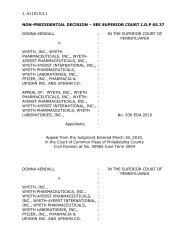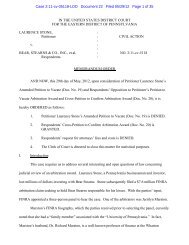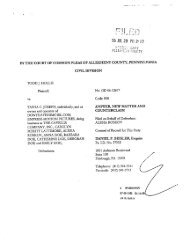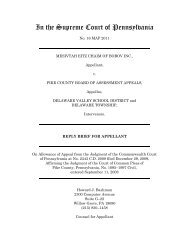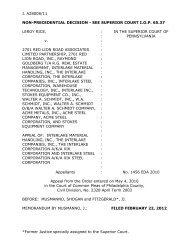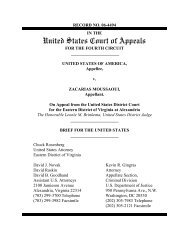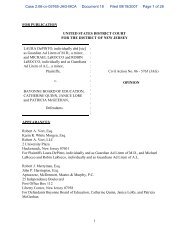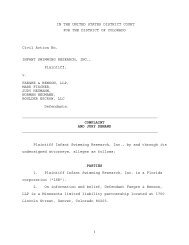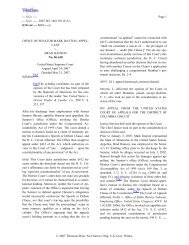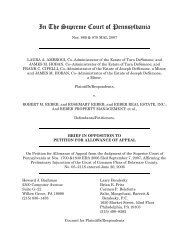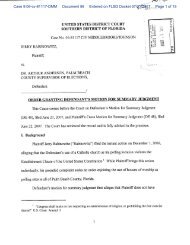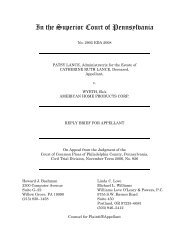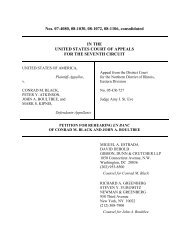In the Superior Court of Pennsylvania - How Appealing
In the Superior Court of Pennsylvania - How Appealing
In the Superior Court of Pennsylvania - How Appealing
Create successful ePaper yourself
Turn your PDF publications into a flip-book with our unique Google optimized e-Paper software.
east cancer but less than two years after <strong>the</strong> results <strong>of</strong> <strong>the</strong> WHI study had become<br />
public.<br />
Mrs. Simon’s case went to trial in <strong>the</strong> Philadelphia <strong>Court</strong> <strong>of</strong> Common Pleas,<br />
where a jury returned a damages verdict in her favor. Among o<strong>the</strong>r things, <strong>the</strong> jury<br />
found that Mrs. Simon’s lawsuit was timely filed under <strong>the</strong> discovery rule. On<br />
defendant Upjohn’s post–trial motion for judgment notwithstanding <strong>the</strong> verdict,<br />
however, <strong>the</strong> trial judge granted j.n.o.v. in Upjohn’s favor ruling, among o<strong>the</strong>r<br />
things, that Mrs. Simon’s lawsuit was time–barred as a matter <strong>of</strong> law based on<br />
Judge Tereshko’s earlier opinion in <strong>the</strong> Coleman case holding that <strong>the</strong> statute <strong>of</strong><br />
limitations began to run immediately on receiving a diagnosis <strong>of</strong> breast cancer even<br />
before <strong>the</strong> WHI study’s results had become public.<br />
The <strong>Superior</strong> <strong>Court</strong>’s ruling in Simon reversed <strong>the</strong> trial court’s entry <strong>of</strong><br />
j.n.o.v. in Upjohn’s favor. <strong>In</strong> Simon, a unanimous three–judge panel <strong>of</strong> <strong>the</strong> <strong>Superior</strong><br />
<strong>Court</strong> ruled that <strong>the</strong> question <strong>of</strong> <strong>the</strong> discovery rule’s applicability was properly<br />
submitted to <strong>the</strong> jury and that <strong>the</strong> evidence presented allowed a rational jury to find<br />
that <strong>the</strong> discovery rule applied and that Mrs. Simon’s lawsuit was timely filed. See<br />
Simon, 989 A.2d at 367–68. <strong>In</strong> deciding <strong>the</strong>se 14 consolidated appeals, <strong>the</strong> <strong>Superior</strong><br />
<strong>Court</strong> explained that its earlier ruling in Simon was controlling. 4<br />
4 Wyeth and Upjohn incorrectly contend, in <strong>the</strong>ir Petition for Allowance <strong>of</strong><br />
Appeal filed in <strong>the</strong>se 14 consolidated cases, that Upjohn was unable to seek review<br />
in this <strong>Court</strong> <strong>of</strong> <strong>the</strong> Simon case because that case settled. That contention is simply<br />
not credible. The Simon case did not settle until August 2010, by which time <strong>the</strong><br />
ordinary periods for seeking fur<strong>the</strong>r review <strong>of</strong> <strong>the</strong> Simon ruling, which <strong>the</strong> <strong>Superior</strong><br />
<strong>Court</strong> issued on December 31, 2009, had long since expired. <strong>In</strong> <strong>the</strong> Simon case,<br />
Upjohn deliberately opted to pursue relief on its motion for a new trial, which <strong>the</strong><br />
– 20 –



